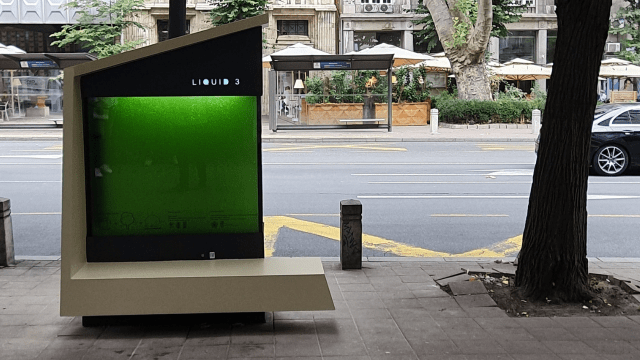Today I’m bringing your attention to ‘liquid trees’, an invention that has been going viral on Twitter over the past week and condenses the CO2 filtering properties of proper trees into an algae-filled box.
The post below from @yupthatexists reveals a ‘liquid tree’ installation in Belgrade, Serbia. It’s a funky-looking thing, kind of reminiscent of a prop you might have seen in Star Trek or Doctor Who.
Scientists create Liquid Trees; a tank full of water and micro-algae that could be an alternative to trees in urban areas. pic.twitter.com/PMFuqbfJK8
— Yup That Exists (@yupthtexists) March 29, 2023
But it’s very much real and has been operating in Serbia since September 2021. It’s not a new invention, but it is quite notable. It solves a niche problem, even if people in the replies don’t understand why ‘solid’ trees won’t cut it.
It’s called a ‘LIQUID3’ (get it? tree? three? I think it’s cute). It was designed at the University of Belgrade, Serbia, in collaboration with the United Nations Development Program, to reduce carbon dioxide emissions in Urban areas.
The concept addresses CO2 reduction in areas where it’d be difficult to plant trees, such as extremely condensed inner-city areas. It’s technically called a photo-bioreactor, and it has a few purposes in public.
“The project is designed to be multifunctional. LIQUID3 is also a bench, it has chargers for mobile phones, as well as a solar panel, thanks to which the bench has lighting during the night,” the head of the department for social affairs and development projects in the municipality of Stari grad Bojan Bojić said (the LIQUID3 is located in this municipality). The project was developed with help from the UNDP.
“The photobioreactor is a completely new biotechnological solution for air purification and the production of oxygen. In an aquarium of six hundred litres of water, we have algae that bind carbon dioxide and produce pure oxygen through photosynthesis.”
One of the particular advantages the microalgae in the tank have over trees and grass is that it’s between 10 and 50 times more efficient at reducing CO2 in an area.
Additionally, in circumstances where pollution is so intense that trees can’t effectively grow, this microalgae solution can be deployed, as these organisms can survive such conditions.
“Our goal is not to replace forests, but to use this system to fill those urban pockets where there is no space for planting trees,” added project author Doctor Ivan Spasojevic.
“The microalgae in “LIQUID 3″ replace two 10-year-old trees or 200 square meters of lawn. The system is the same because both trees and grass perform photosynthesis and bind carbon dioxide.”
Anyway, this is a pretty neat project. I’d be interested to see it rolled out in more areas and if there are plans to do so. With that in mind, Gizmodo Australia has reached out to the team to ask where the tech is heading.
